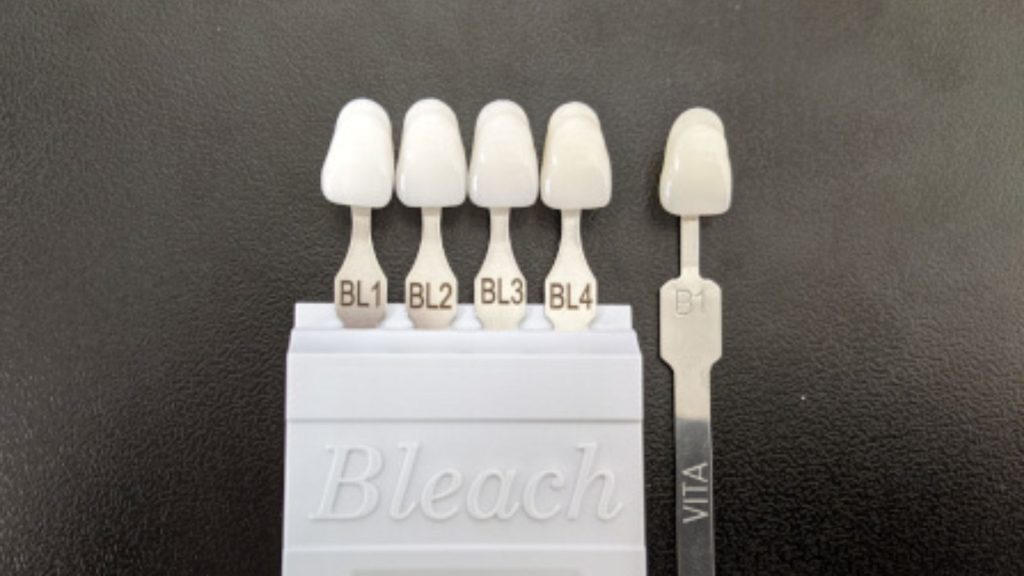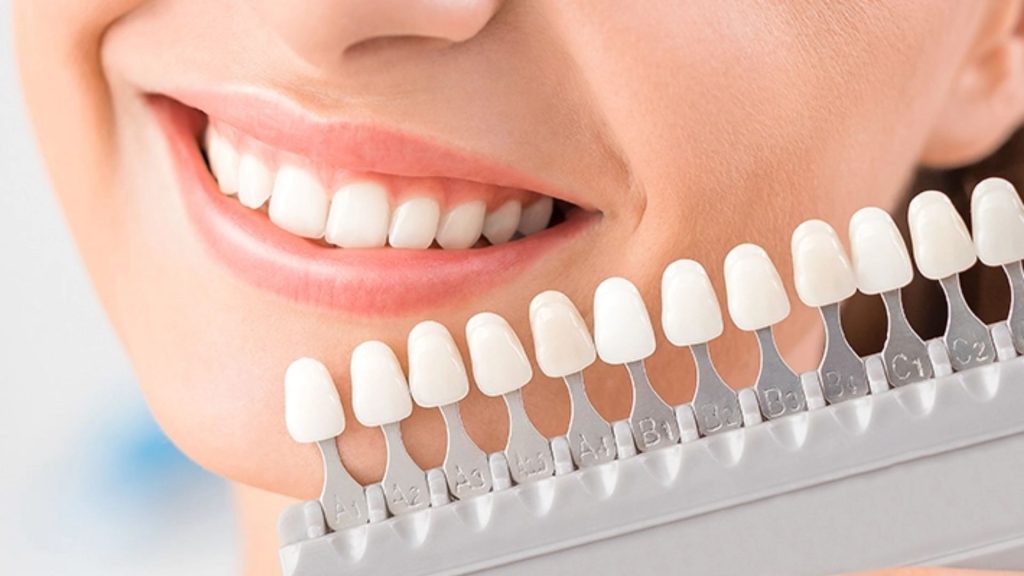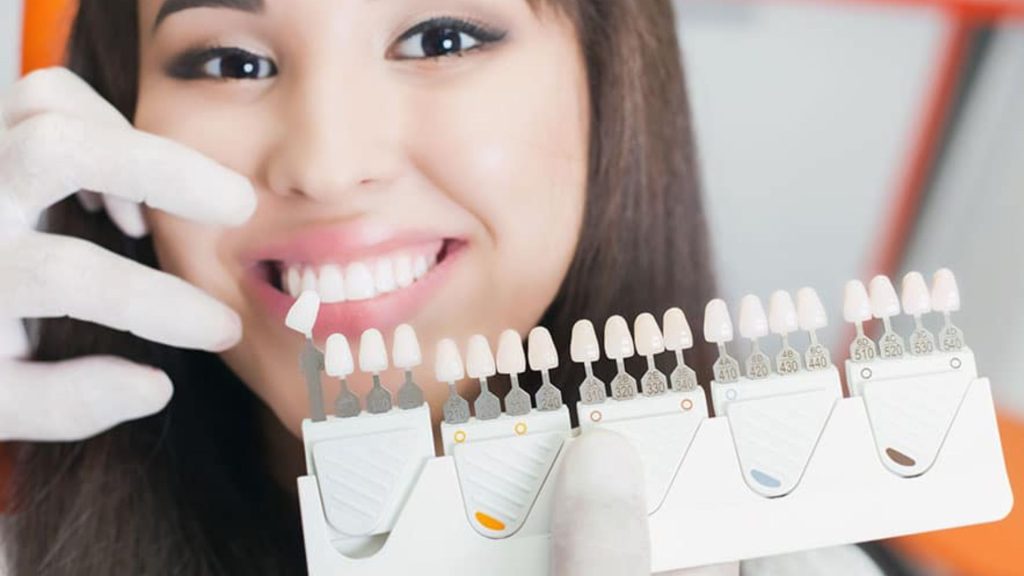What Is The Whitest Shade Of Natural & Artificial Teeth? Natural teeth are whitest at “A1.” Teeth seem whitest and most natural in this tint. B1 or BL1 is utilized to make the whitest and most attractive veneers and crowns.
In cosmetic dentistry, B1 is used to determine tooth color since it matches genuine white teeth. Dental professionals agree that B1 or BL1 is the whitest and most natural-looking tooth color. This article discusses the whitest tint for natural and artificial teeth to help you smile brighter and more confidently.
The Most Common Artificial Teeth Colors Today
Each patient has the option of selecting their own porcelain tooth shade to meet their unique needs. However, these are some of the most common porcelain tooth tones:
Pure white (B1 or BL1)


Pure white ceramic tooth color (B1 or BL1) is one of the most common options and is considered the standard in the dentistry field today. This tone makes the smile shine naturally, bringing out its beauty without making it look too fancy. What makes this porcelain tooth color stand out are:
Teeth made of pure white ceramic are bright and almost the same color as real teeth. This makes a smile that looks natural and nice without using too much polishing. This ceramic color is also clear, so natural light can get through and make the teeth feel more like real teeth. This makes the smile look more real and pretty. Most skin tones and types look good with white artificial teeth. This makes it a safe choice that many people like to make.
Also, you can change the brightness and shine of this porcelain color to fit your style and personal tastes.
Yellow (A or Y)
Gold porcelain tooth color (A or Y) is one way to make your smile stand out and look different. With this warm tone, people smile more and become more friendly. Your grin will seem as inviting as a family supper on an autumn day when you wear yellow.
In addition, the contrast that yellow tones provide with skin tones makes your grin more noticeable. This might make you seem confident and beautiful. Yellow isn’t as popular as pure white, but it works for some people who have yellow skin or who want a smile that stands out and feels warm. Choosing the color of gold porcelain teeth demands attention and technical help from your dentist to meet your own style and aspirations.
Lastly, having yellow porcelain teeth can give you a unique and warm smile that makes people feel close and at ease.
Gray (C or GR)
C or GR gray porcelain tooth tint is unique in dentistry. With this tone, your grin becomes distinctive and draws attention. Gray porcelain tooth color is distinguished by its individuality and distinction.
The dramatic contrast between the gray and flesh tone highlights the grin. For a distinctive look, gray porcelain teeth may be right for you. However, bear in mind that gray is not usually seen to be the most natural porcelain hue.
As a result, selecting this hue necessitates technical guidance from a dentist to guarantee that it is appropriate for you and will result in a distinctive, outstanding smile that complements your particular style. Gray porcelain teeth may produce a one-of-a-kind grin that highlights your distinct personality.
Bronze (R or OR)
R or OR bronze porcelain tooth hue is distinctive, warm, and appealing. This hue is often used to produce a grin with particular qualities that represent the distinctive personality of the individual who plays a vital role in the smile. Bronze may produce a nice contrast with skin tone, making the grin more obvious and unforgettable. Although bronze is not the most natural porcelain hue, it does have one advantage. It provides the grin with an appealing and unusual appearance, helps you stand out in a chart, and creates a significant impact on others.
Furthermore, bronze porcelain tooth color is very changeable, from brightness to gloss, enabling you to tailor it to your own tastes and preferences. This enables you to convey your uniqueness and originality via your grin.
What Is The Whitest Shade Of Natural & Artificial Teeth?


An attractive smile and healthy teeth go hand in hand. White teeth are a certain way to create a good first impression on everybody you meet. However, we need to study both natural teeth and artificial teeth to better grasp the “Whitest” aspect of teeth:
Whitest Natural Teeth
Dentists utilize the Vita Classical Shade Guide which classifies normal teeth as “A1” white. A1 is a milky, clean white without yellow or gray. This is the natural tooth color most people appreciate and associate with clean, healthy teeth.
However, genuine teeth may vary in color across people and even within a mouth. Genetic factors, age, dental care regimen, and the impact of food and drink may all influence the color of teeth. Many utilize teeth-whitening solutions to get the whitest natural teeth color. Dentists should whiten teeth for safety and natural outcomes.
The Whitest Artificial Teeth
The “B1” shade of fake teeth is the whitest option in the industry standard Vita Classical color Guide for use in dental offices. There is very little if any trace of yellow or gray in B1, which is a clean, creamy white. Because it creates such a radiant and natural-looking grin, this shade of fake teeth is quite popular.
However, the hue of artificial teeth may be customized to the user’s tastes. An individual might ask a dentist to bleach or bleach their prosthetic teeth.
Why Should You Care About Artificial Teeth Color?
Paying attention to the color of porcelain teeth is a significant aspect of dental operations and smile enhancement. Porcelain color is not just a matter of science; it also has huge benefits in terms of look and confidence. People get a good first impression from a confident smile with good plastic teeth. It boosts confidence and self-expression. Porcelain teeth should match your skin tone to enhance your smile. Others see you as powerful and seductive because of this compatibility.
Furthermore, the color of porcelain teeth is natural and complementary to your real teeth, resulting in a natural and appealing smile. For no one to notice your oral cosmetics, naturalness is key.
Also, you can make your ceramic teeth any color you want, giving you a smile that fits your unique style and taste. Maintaining oral health is part of porcelain tooth care. To preserve a lovely smile, you’ll likely take better care of your dental health.
How to Choose the Best Ceramic Teeth Color?


Choosing the color of artificial teeth is a significant step in dental treatment, particularly if you are contemplating porcelain dental implants, porcelain filling materials, or smile makeover operations. Consider the following variables when selecting the appropriate porcelain tooth hue for your smile:
Pick Artificial Teeth Match Actual Teeth
When getting porcelain teeth, it’s crucial to choose a shade that closely matches the shade of your actual teeth so that your smile appears consistent and natural.
First, ask your doctor or another tooth worker for help. The optimum porcelain tooth hue for you will be determined by their expertise.
When choosing the right shade, it’s important to think about the milky white parts of your teeth. Your dentist may do this to guarantee that the hue of your porcelain teeth matches your natural color.
Also, you need to think about how the color of the plastic tooth will look with the rest of your teeth. Conformity and consistency with surrounding teeth are essential for creating a natural and beautiful smile.
The porcelain tooth color that best matches your natural look may be chosen from your dentist’s porcelain color samples in various lighting circumstances.
Match Porcelain Teeth To Skin Tone
Choosing the color of your artificial teeth based on the color of your skin is a smart way to make sure your smile looks natural and goes with your overall look.
First and foremost, identify your skin tone. Warm skin tones, like yellow or warm pink, look good with porcelain tooth colors that have a hint of yellow or cream. Natural balance and harmony result.
If you have cool skin tones, such as cold pink or cool blue, pure white or green porcelain is frequently a wonderful option. This contrast will brighten and rejuvenate the grin. Your dentist has the expertise to help.
Discuss it with them and request a ceramic color sample to taste. Finally, considering porcelain tooth color in different lighting settings ensures that it looks natural and acceptable in all scenarios. Color-matching porcelain teeth to your skin tone may produce a natural-looking grin. Consult with your dentist to guarantee this option yields optimal outcomes and confidence.
Select Artificial Teeth That Match Your Eyes
The fun method to build a smile that expresses your personality and personal style is to choose the color of your porcelain teeth depending on the color of your eyes. You should start by identifying your eye color. A porcelain tooth shade with a hint of yellow or cream might be a nice option if your eyes are a vibrant color, such as brown or pink. This mixture will bring out the best in the eyes with a warm tone while without overpowering them.
On the other hand, if you have cool-toned eyes, such as blue or green, you should choose pure white or green porcelain teeth. This contrast, paired with your cool eye color, may produce a young, bright grin.
Which Artificial Teeth Clinic Is Reliable And Safe?
Choosing the proper porcelain tooth color is crucial in the quest for the ideal smile. We’ve talked about a lot of different colors of porcelain teeth, from clear white to gold, gray, and bronze. Each has its own look. However, when you trust Spring Orchid Dental Clinic for dental veneers, we will provide you with the greatest smile option.
At Spring Orchid Dental Clinic, we know that tooth color is about confidence, naturalness, and beauty. We manufacture pure white porcelain teeth (B1 or BL1) natural and brilliant and tailor every aspect to match you.
Let us help you create a beautiful and confident grin since a bright smile shows your attractiveness and confidence.
FAQs
Is BL4 Whiter Than B1?
No, BL4 porcelain is not whiter than B1. In the porcelain tooth color system, B1 is one of the whitest porcelain tooth tones and is often thought of as pure white. Meanwhile, BL4 is white but has a little blue (Blue Hue) and gray (Gray Shade) added to it, so it is not as white as B1.
What Color Whitens Teeth Best?
The whitest ceramic tooth color is either B1 or BL1. These are porcelain tooth tones that are regarded as pure white and are almost identical to the hue of real teeth. They make you seem confident and appealing with a natural, shining whiter grin. However, the color of your porcelain teeth is also determined by your skin tone, personal style, and preferences. To whiten and naturalize your teeth, a skilled dentist might recommend a porcelain shade.
What Distinguishes B1 And BL4 Veneers?
When it comes to beautifying your smile, B1 and BL4 veneers are 2 distinct color possibilities. The primary distinction between them is in hue and whiteness. B1 is a pure white porcelain tooth tone that is almost identical to the color of real teeth, giving the smile a more natural and shining appearance. It is a popular option for achieving a white, natural-looking grin.
Meanwhile, BL4 is a white tone with a blend of blue and gray tones, making it less white than B1 and including a little of blue and gray tones. The decision between B1 and BL4 is determined by your smile and skin tone objectives. B1 is a popular option for achieving a white, natural smile.
However, if you prefer a specific color combination or if the state of your teeth necessitates a more specialized tone, BL4 may be a viable option.





